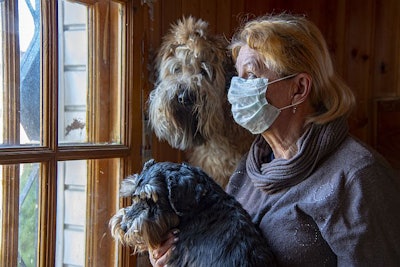
On June 2, the United States Department of Agriculture’s National Veterinary Services Laboratories (NVSL) publicly confirmed the first case of SARS-CoV-2 coronavirus infection in a pet dog in the U.S.
Dog infected with coronavirus in New York
The dog, a German Shepherd in New York, tested positive for the virus that causes COVID-19. One of the dog’s owners tested positive for the virus, while the other showed symptoms, prior to the dog. After the dog began showing signs of respiratory illness, veterinarians took samples. Private labs tested the samples and found them positive for SARS-CoV-2 coronavirus infection. The laboratory reported their findings to NVSL. Another dog in the house exhibited no symptoms, but did carry antibodies that suggested exposure to the pathogen.
Other reports of coronavirus infection in pets
Earlier reports of infection in a pet dog, a Pug named Winston, proved to be incorrect. In May, NVSL identified two separate coronavirus infections of cats in New York. In the first recorded example of a pet infected with the virus, a Pomeranian in Hong Kong tested positive for the coronavirus SARS-CoV-2 in late February.
Globally, relatively few cases of SARS-CoV-2 coronavirus infection have occurred in pets compared to people. However, some animals may be susceptible.
Scientists at the Harbin Veterinary Research Institute in China directly inoculated domestic cats with the SARS-CoV-2 coronavirus, which causes COVID-19 disease in humans. The scientists conducted similar trials with dogs, pigs, chickens, ferrets and ducks. The virus could replicate in ferrets and cats, but none of the other animals. Two out of six cats in the experiment seem to have caught the virus after exposure to an inoculated cat.
Hypothetical cat flu outbreak
While the risk of pets transmitting the disease seems very low, even the rumor that pets could transmit the SARS-CoV-2 coronavirus led people to abandon their dogs and cats in the streets in some regions, as the BBC reported. What if a disease erupted that could spread from pets to people and vice versa? The World Health Organization (WHO) prepared for just that scenario with a simulation exercise in 2017, one of an annual series of drills called Exercise Crystal.
WHO doctors used the exercise to test the outbreak responses of 30 countries and area in the Western Pacific region. The simulation supposed that a previously unknown illness began spreading among cats. Meanwhile, cat owners and veterinarians also start reporting flu-like symptoms to their doctors. By the end of the hypothetical outbreak, cat flu had infected hundreds of people in participants’ own countries and spread internationally.
“While a scenario involving pet cats initially seems absurd, it is actually not too far from the truth,” WHO official Dr. Masaya Kato said on the agency’s website. “Zoonotic diseases—that is, diseases which are transmitted between animals and humans—are something we have to prepare for. Some recent examples have been avian influenza, Middle East respiratory syndrome and plague. We wanted participants to think through what they would do if faced with such a scenario. Do they know how to reach their animal health counterparts? And do they know when and how to notify WHO?”

















